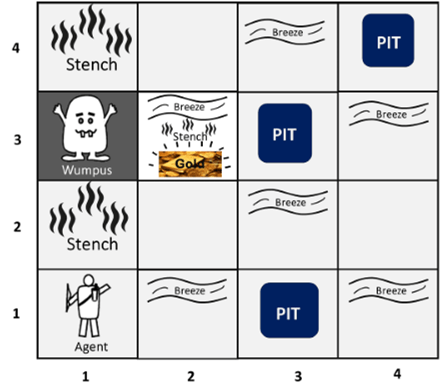The Wumpus World in Artificial intelligenceWumpus world:The Wumpus world is a simple world example to illustrate the worth of a knowledge-based agent and to represent knowledge representation. It was inspired by a video game Hunt the Wumpus by Gregory Yob in 1973. The Wumpus world is a cave which has 4/4 rooms connected with passageways. So there are total 16 rooms which are connected with each other. We have a knowledge-based agent who will go forward in this world. The cave has a room with a beast which is called Wumpus, who eats anyone who enters the room. The Wumpus can be shot by the agent, but the agent has a single arrow. In the Wumpus world, there are some Pits rooms which are bottomless, and if agent falls in Pits, then he will be stuck there forever. The exciting thing with this cave is that in one room there is a possibility of finding a heap of gold. So the agent goal is to find the gold and climb out the cave without fallen into Pits or eaten by Wumpus. The agent will get a reward if he comes out with gold, and he will get a penalty if eaten by Wumpus or falls in the pit. Note: Here Wumpus is static and cannot move.Following is a sample diagram for representing the Wumpus world. It is showing some rooms with Pits, one room with Wumpus and one agent at (1, 1) square location of the world.  There are also some components which can help the agent to navigate the cave. These components are given as follows:
PEAS description of Wumpus world:To explain the Wumpus world we have given PEAS description as below: Performance measure:
Environment:
Actuators:
Sensors:
The Wumpus world Properties:
Exploring the Wumpus world:Now we will explore the Wumpus world and will determine how the agent will find its goal by applying logical reasoning. Agent's First step: Initially, the agent is in the first room or on the square [1,1], and we already know that this room is safe for the agent, so to represent on the below diagram (a) that room is safe we will add symbol OK. Symbol A is used to represent agent, symbol B for the breeze, G for Glitter or gold, V for the visited room, P for pits, W for Wumpus. At Room [1,1] agent does not feel any breeze or any Stench which means the adjacent squares are also OK.  Agent's second Step: Now agent needs to move forward, so it will either move to [1, 2], or [2,1]. Let's suppose agent moves to the room [2, 1], at this room agent perceives some breeze which means Pit is around this room. The pit can be in [3, 1], or [2,2], so we will add symbol P? to say that, is this Pit room? Now agent will stop and think and will not make any harmful move. The agent will go back to the [1, 1] room. The room [1,1], and [2,1] are visited by the agent, so we will use symbol V to represent the visited squares. Agent's third step: At the third step, now agent will move to the room [1,2] which is OK. In the room [1,2] agent perceives a stench which means there must be a Wumpus nearby. But Wumpus cannot be in the room [1,1] as by rules of the game, and also not in [2,2] (Agent had not detected any stench when he was at [2,1]). Therefore agent infers that Wumpus is in the room [1,3], and in current state, there is no breeze which means in [2,2] there is no Pit and no Wumpus. So it is safe, and we will mark it OK, and the agent moves further in [2,2].  Agent's fourth step: At room [2,2], here no stench and no breezes present so let's suppose agent decides to move to [2,3]. At room [2,3] agent perceives glitter, so it should grab the gold and climb out of the cave. Next TopicKnowledge-base for Wumpus world |